|
HISTORIC HIGHWAY BRIDGES OF OREGON
|

|
APPENDIX E
RESERVE BRIDGES
In the evaluation of Oregon's highway bridges, fifty-three structures were delegated to a reserve category. These structures are not eligible for the National Register, but do exhibit some historic and technological importance. These structures were not considered National Register eligible due primarily to incompatible structural modifications, lack of available historic information, or the existence of better examples of the structure type in the state. In future years, these bridges will be reevaluated against the National Register eligibility criteria. As historic bridges are lost and new historic information is obtained on the reserve structures, some of the reserve bridges may be found National Register eligible.
The fifty-three reserve bridges are listed below, followed by photo-descriptions of the bridges. They are arranged by type, in order: truss, arch, moveable, and slab, beam, and girder. Within each type, the bridges are in chronological order by construction date.
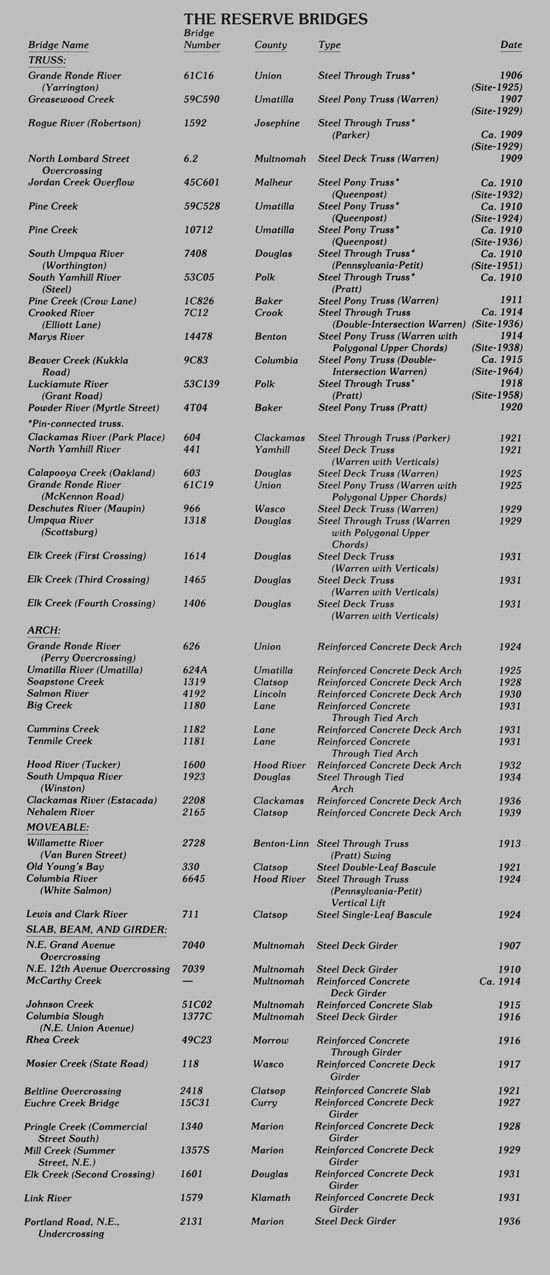
|
TRUSS
|
Grande Ronde River (Yarrington) Bridge Structure Number 61C16 Constructed - 1906 (Site-1925) Steel Through Truss (Pratt) Yarrington-Scott County Road 49 Palmer Junction, Union County Ownership - Union County |
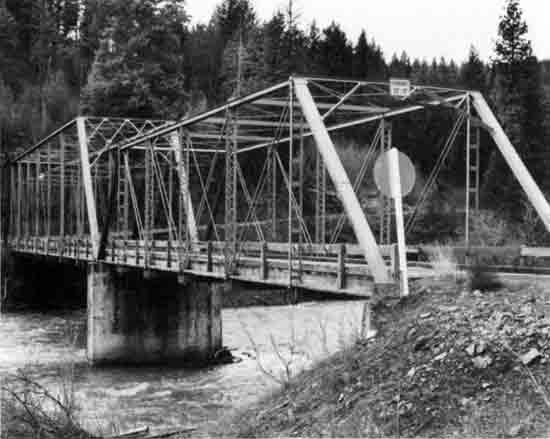 |
|
Moved to this site in 1925, this two-span steel Pratt truss is an example of the pin-connected construction technology used prior to about 1915. The structure is 250 feet long, consisting of 150-foot and 100-foot through truss spans. A name plaque attached to the 100-foot span indicates that it was built in 1906 by P.S. Easterday and Company of Walla Walla. | |
|
Greasewood Creek Bridge Structure Number 59C590 Constructed - 1907 (Site-1929) Steel Pony Truss (Warren) County Road 854 Adams vicinity, Umatilla County Ownership - Umatilla County |
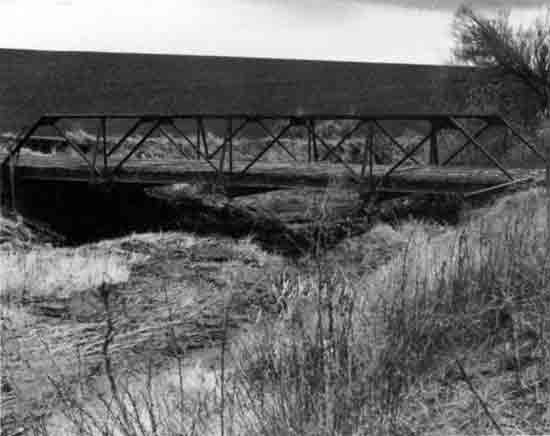 |
|
This 60-foot steel Warren pony truss is located on a lightly-traveled county road in the rolling farmland of northeast Oregon. It is the oldest Warren truss on Oregon's highway system and also is the earliest example in the state with riveted truss connections. The structure has a timber roadway deck and is constructed from relatively light-gauge angle steel. The sway braces are an unusual feature on this pony truss. Half of the original name plaque is missing, leaving only the first names of the local officials from the period. The bridge was built by P.S. Easterday Company of Walla Walla, Washington. | |
|
Rogue River (Robertson) Bridge Structure Number 1592 Constructed - Ca. 1909 (Site-1929) Steel Through Truss (Parker) Rogue River Loop Highway 260, M.P. 12.91 Merlin Vicinity, Josephine County Ownership - State of Oregon |
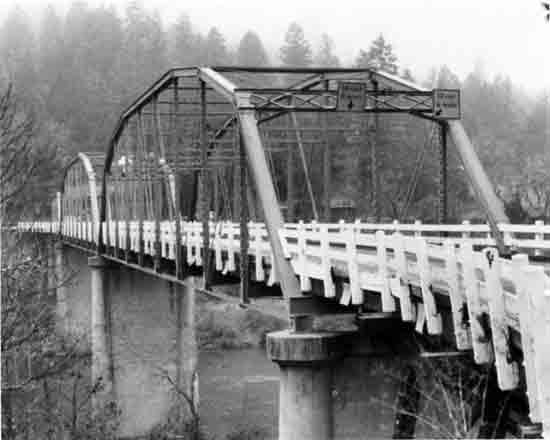 |
|
The Robertson Bridge, named for early Oregon pioneers who settled near the area in the 1870s, is a 583-foot three-span steel through truss structure with one 90-foot Pratt truss, two 180-foot Parker trusses, and seven timber frame approach spans. The three truss spans are all pin-connected. Twenty-five pin-connected truss highway bridges remain in Oregon. The bridge was moved to its present site in 1929 from a location on the Pacific Highway over the Rogue River in Grants Pass, where it was replaced by the Caveman Bridge (1931). The county officials listed on the nameplate provide a dating of the structure, circa 1909. | |
|
North Lombard Street Overcrossing Structure Number 6.2 Constructed - 1909 Steel Deck Truss (Warren) North Lombard Street Portland, Multnomah County Ownership - Burlington Northern Railroad |
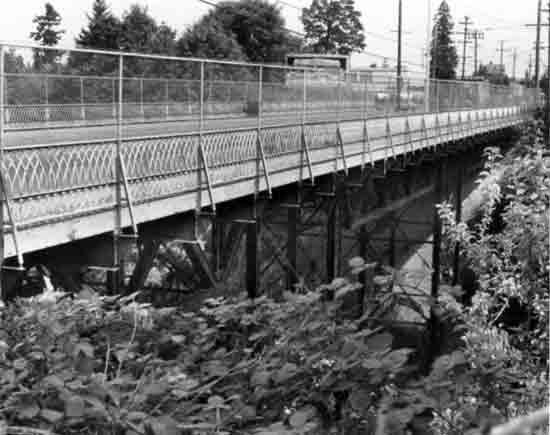 |
|
Constructed in 1909 by the Spokane, Portland, and Seattle Railroad, this structure consists of three 90-foot hanging Warren truss spans supported on steel towers. The truss members are rivet connected. Similar to two neighboring truss bridges on North Fessenden Street and North Willamette Boulevard, the structure was designed by noted engineer Ralph Modjeski. The bridge has a vintage lattice steel handrail. (Additional information about the Spokane, Portland, and Seattle Railroad project in North Portland is in the description of the North Fessenden Street Overcrossing.) | |
|
Jordan Creek Overflow Bridge Structure Number 45C601 Constructed - Ca. 1910 (Site-1932) Steel Pony Truss (Queenpost) County Road 808 Jordan Valley vicinity, Malheur County Ownership - Malheur County |
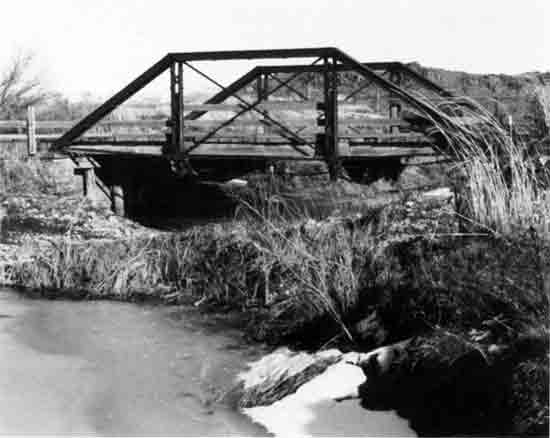 |
|
This structure is a 32-foot pony truss span of queenpost configuration. The bridge is pin connected, indicating a construction date of about 1910. Records show the bridge was moved to the site in 1932. The bridge has a timber roadway deck and is located on a lightly-traveled county road. This truss bridge is one of very few in Oregon supported by masonry abutments. | |
|
Pine Creek Bridge Structure Number 59C528 Constructed - Ca. 1910 (Site-1924) Steel Pony Truss (Queenpost) County Road 707 Umapine vicinity, Umatilla County Ownership - Umatilla County |
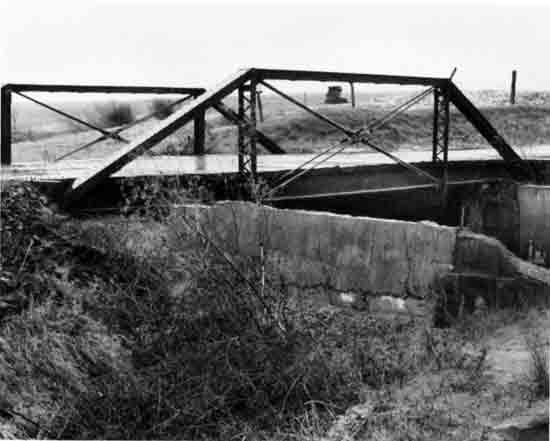 |
|
This structure is a 40-foot steel queenpost pony truss. The bridge is one of four queenpost trusses on Oregon's highway system, one of six pin-connected pony trusses and one of twenty-five highway trusses (pony and through) using pin-connections. The bridge was installed at its current site in 1924. | |
|
Pine Creek Bridge Structure Number 10712 Constructed - Ca. 1910 (Site-1936) Steel Pony Truss (Queenpost) County Road 676 Weston vicinity, Umatilla County Ownership - Umatilla County |
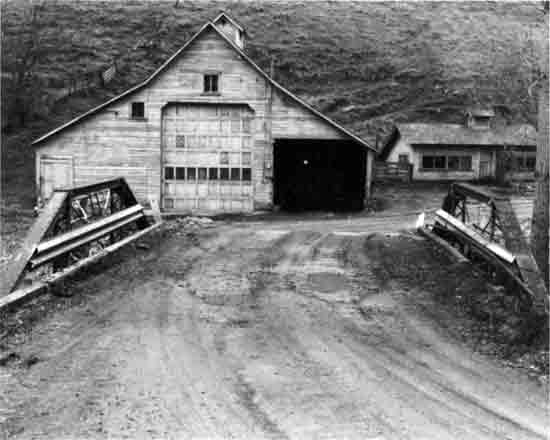 |
|
The Pine Creek Bridge is a 40-foot steel pony truss of queenpost configuration. Its construction date is established on the basis of the pin-connected technology, largely obsolete by 1915. It is one of only four queenpost trusses on Oregons highway system and one of twenty-five pin-connected trusses. The bridge was moved to this site in 1936. | |
|
South Umpqua River (Worthington) Bridge Structure Number 7408 Constructed - Ca. 1910 (Site-1951) Steel Through Truss (Pennsylvania-Petit) County Road 42, M.P. 8.82 Days Creek, Douglas County Ownership - Douglas County |
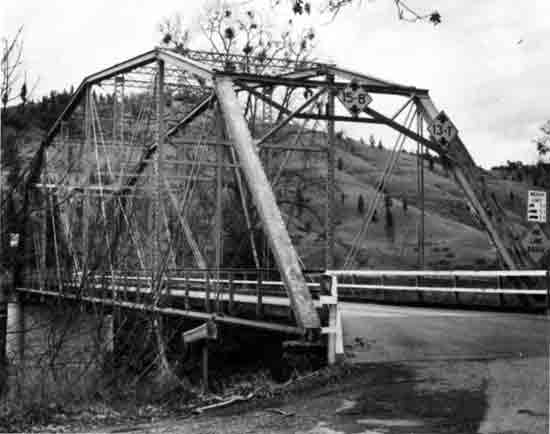 |
|
Known locally as the Worthington Bridge, this bridge is one of Oregon's twenty-five pin-connected highway truss spans. The bridge was moved from its original location on the Rogue River to this site in 1951, when it was modified from 190 feet to its current length of 153 feet. Though its construction date is unknown, the use of pin-connection technology indicates a construction date of about 1910. | |
|
South Yamhill River (Steel) Bridge Structure Number 53C05 Constructed - Ca. 1910 Steel Through Truss (Pratt) County Road 669 (Closed) Willamina, Polk County Ownership - Polk County |
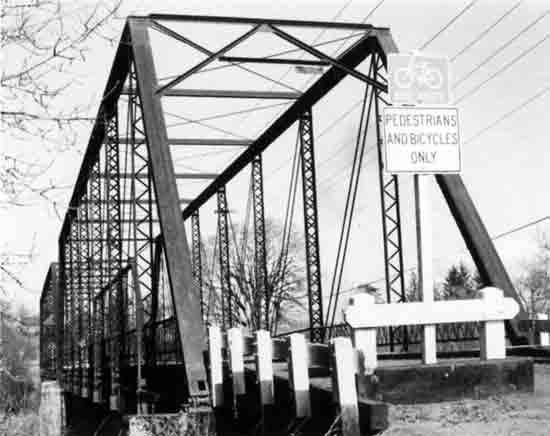 |
|
Two 149-foot steel through truss spans make up this 325-foot long bridge. The Pratt trusses are connected with pins. The one lane bridge is closed to vehicular traffic. | |
|
Pine Creek (Crow Lane) Bridge Structure Number 1C826 Constructed - 1911 Steel Pony Truss (Warren) Crow Lane County Road 1027 Halfway vicinity, Baker County Ownership - Baker County |
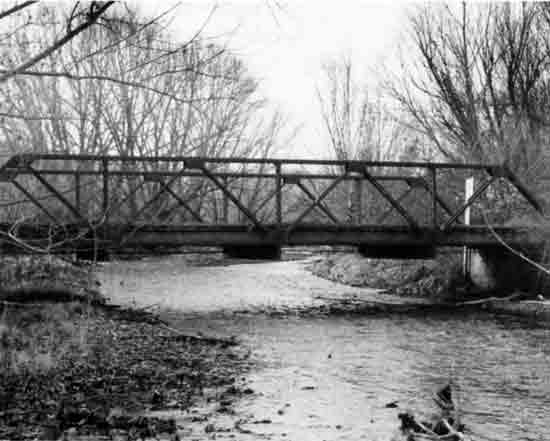 |
|
This 53-foot steel structure is one of the oldest Warren pony trusses on Oregon's highway system. It is also one of the oldest bridges in Oregon with truss members connected with rivets. | |
|
Crooked River (Elliott Lane) Bridge Structure Number 7C12 Constructed - Ca. 1914 (Site-1936) Steel Through Truss (Double-Intersection Warren) Elliott Lane County Road 124 Prineville vicinity, Crook County Ownership - Crook County |
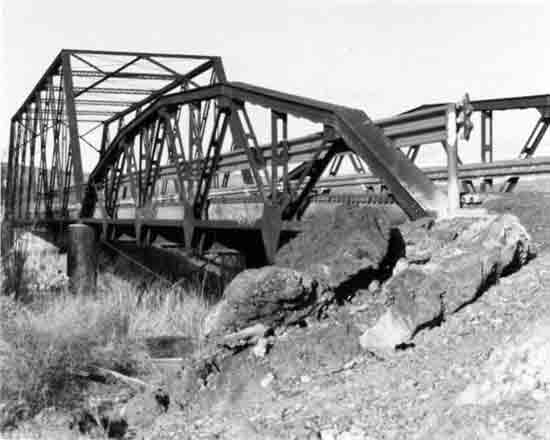 |
|
One of only two steel through trusses of double-intersection Warren configuration remaining on Oregon's highway system, the Elliott Lane Bridge consists of a 125-foot through truss main span and an 80-foot Warren with polygonal upper chords pony truss. The truss members are connected with rivets. The through truss was probably constructed by the Coast Bridge Company in 1914, relocated, and lengthened (with the pony truss addition) in 1936. | |
|
Marys River Bridge Structure Number 14478 Constructed - 1914 (Site-1938) Steel Pony Truss (Warren with Polygonal Upper Chords) Harris County Road 16520 Alder vicinity, Benton County Ownership - Benton County |
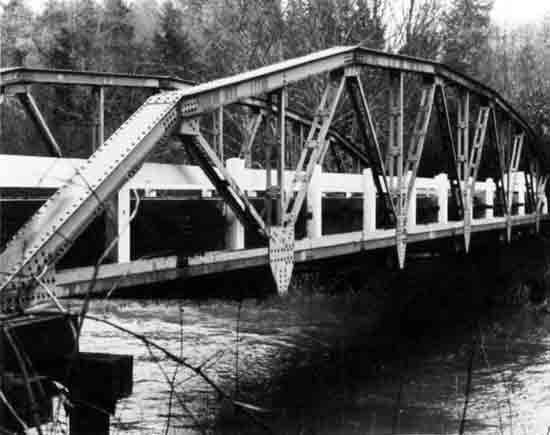 |
|
Built by the Coast Bridge Company of Portland in 1914, this 138-foot steel pony truss was moved to its present site in 1938. The truss is rivet-connected and a Warren with polygonal upper chords. | |
|
Beaver Creek (Kukkla Road) Bridge Structure Number 9C83 Constructed - Ca. 1915 (Site-1964) Steel Pony Truss (Double-Intersection Warren) Kukkla County Road 4087 Clatskanie vicinity, Columbia County Ownership - Columbia County |
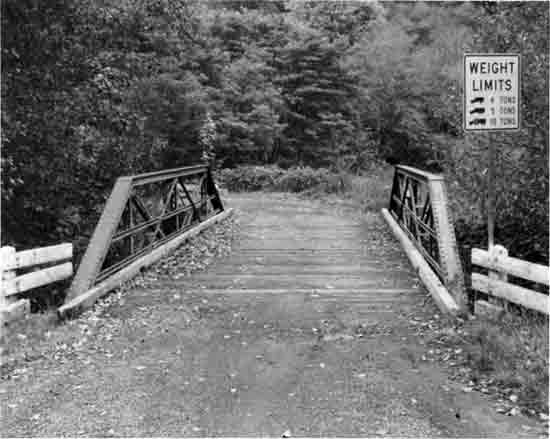 |
|
The Kukkla Road Bridge is a 48-foot, rivet-connected steel pony truss. It is the only pony truss in Oregon with a double-intersection Warren truss. The structure was purchased by the county from the state and moved to this location in 1964. Its original location is believed to have been near the Oregon Coast. | |
|
Luckiamute River (Grant Road) Bridge Structure Number 53C139 Constructed - 1918 (Site-1958) Steel Through Truss (Pratt) Grant County Road 1062 Kings Valley vicinity, Polk County Ownership - Polk County |
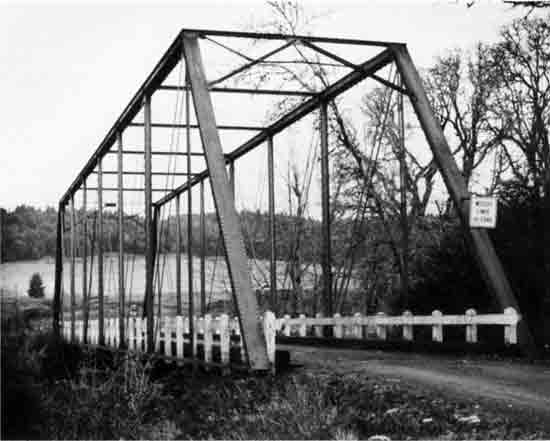 |
|
This 140-foot pin-connected Pratt truss span is one of twenty-five remaining pin-connected highway trusses in Oregon. Originally spanning the Luckiamute River at another location in the northern part of Polk County, this 1918 bridge was relocated to its present site in 1958. The steel grate decking is from the old Morrison Street Bridge (1905), Portland. | |
|
Powder River (Myrtle Street) Bridge Structure Number 4T04 Constructed - 1920 Steel Pony Truss (Pratt) Myrtle Street Baker, Baker County Ownership - Baker County |
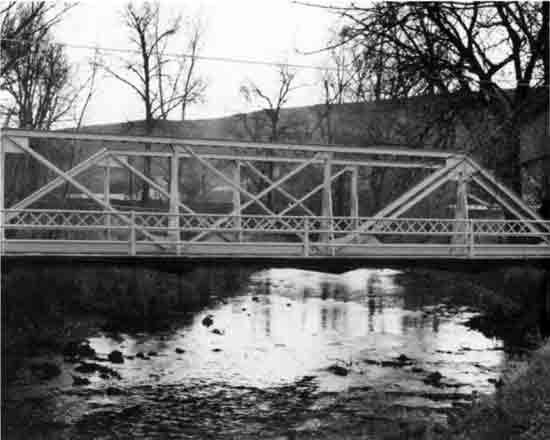 |
|
This 65-foot steel pony truss is a Pratt with rivet connections. It was built by the City of Baker and displays diagonal bracing of the vertical truss members to increase lateral strength in the event of high water. | |
|
Clackamas River (Park Place) Bridge Structure Number 604 Constructed - 1921 Steel Through Truss (Parker) 82nd Avenue (Closed) Gladstone, Clackamas County Ownership - City of Gladstone |
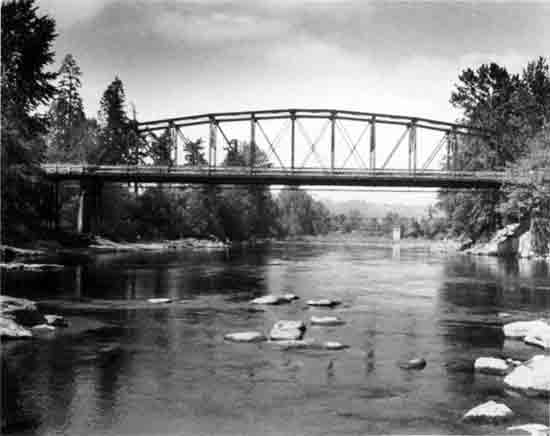 |
|
Originally a major crossing of the Clackamas River on the route from Oregon City to Portland, this 220-foot steel through truss span has been closed to traffic since 1976, but is being reopened for bicycle and pedestrian traffic. The truss is a Parker with rivet connections. | |
|
North Yamhill River Bridge Structure Number 441 Constructed - 1921 Steel Deck Truss (Warren with Verticals) Pacific Highway West 1W, M.P. 34.99 McMinnville vicinity, Yamhill County Ownership - State of Oregon |
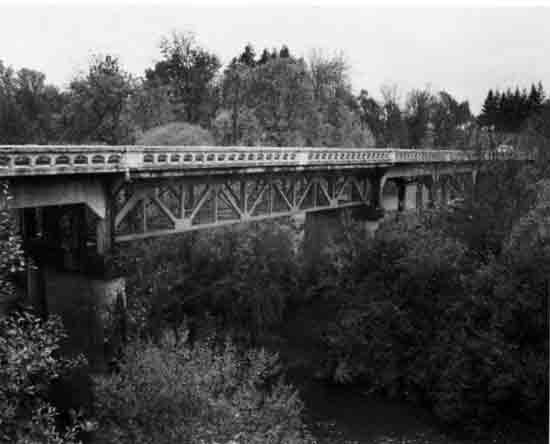 |
|
An 80-foot steel deck truss (Warren with verticals) and seven 40-foot concrete deck girder spans make up this 360-foot bridge. The truss is rivet connected. The structure was designed under the auspices of Conde B. McCullough, State Bridge Engineer. | |
|
Calapooya Creek (Oakland) Bridge Structure Number 603 Constructed - 1925 Steel Deck Truss (Warren) Oakland-Shady Highway 324, M.P. 1.08 Oakland, Douglas County Ownership - Douglas County |
 |
|
Located at Oakland on old Highway 99, this structure consists of a 100-foot steel Warren deck truss and nine concrete deck girder approach spans. The total length of the bridge is 473 feet. The precast concrete railing, bracketing, and overall configuration are representative of a standard state bridge design of the 1920s. | |
|
Grande Ronde River Bridge (McKennon Road) Structure Number 61C19 Constructed - 1925 Steel Pony Truss (Warren with Polygonal Upper Chords) McKennon County Road 132 Imbler vicinity, Union County Ownership - Union County |
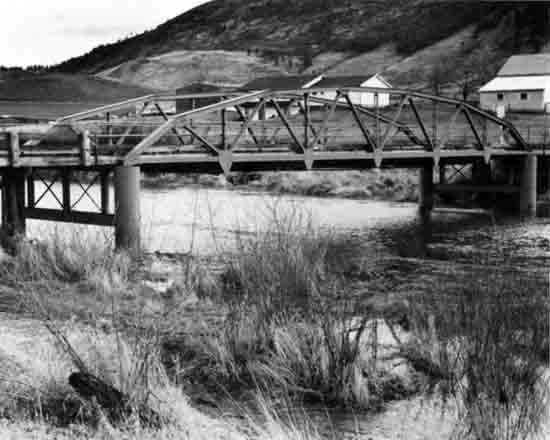 |
|
Lying in the farmland southeast of Imbler, this bridge is a 100-foot steel pony truss. The truss is a Warren with polygonal upper chords and is rivet-connected. The roadway deck is timber, and the support piers are steel caissons. | |
|
Deschutes River (Maupin) Bridge Structure Number 966 Constructed - 1929 Steel Deck Truss (Warren) The Dalles-California Highway 4, M.P. 45.87 Maupin vicinity, Wasco County Ownership - State of Oregon |
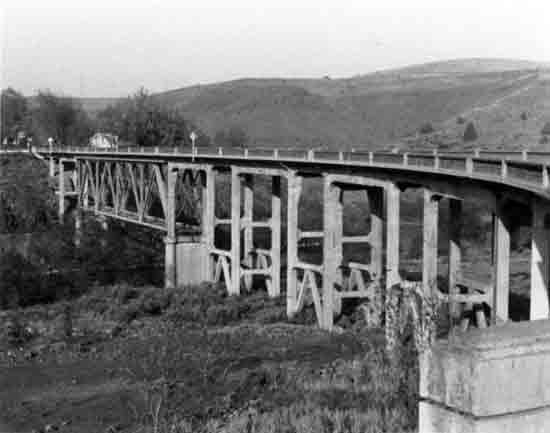 |
|
The Deschutes River Bridge is an 826-foot structure, consisting of a 200-foot steel Warren deck truss and thirteen concrete girder approach spans. The concrete towers, the ornate bridge railing, and soffit bracketing add aesthetic interest to the structure. The structure was designed by Conde B. McCullough and built by the Kuckenberg-Wittman Company. | |
|
Umpqua River (Scottsburg) Bridge Structure Number 1318 Constructed - 1929 Steel Through Truss (Warren with Polygonal Upper Chords) Umpqua Highway 45, M.P. 16.43 Scottsburg, Douglas County Ownership - State of Oregon |
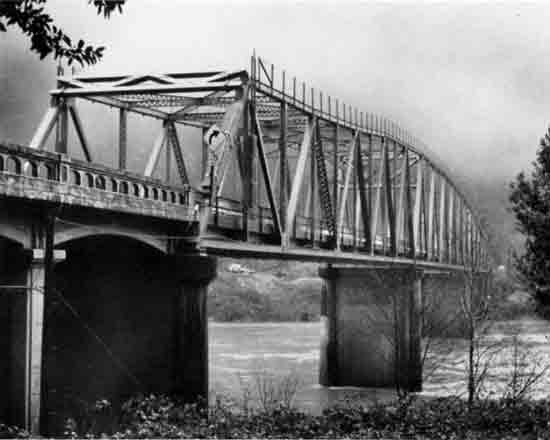 |
|
Three spans form this 643-foot continuous through truss bridge at the historic community of Scottsburg. Designed by Conde B. McCullough, it is very similar to the Willamette River Bridge at Springfield, also constructed in 1929. The Scottsburg Bridge was built by the Clackamas Construction Company. | |
|
Elk Creek (First Crossing) Bridge Structure Number 1614 Constructed - 1931 Steel Deck Truss (Warren with Verticals) Umpqua Highway 45, M.P. 36.39 Elkton vicinity, Douglas County Ownership - State of Oregon |
 |
|
This 140-foot steel deck truss contains a Warren with verticals truss. This bridge, along with three other associated Elk Creek crossings, was designed by Conde B. McCullough and was constructed on the Umpqua Highway in 1931. It is the only one of the four associated Elk Creek crossings to carry a commemorative dedication. A bronze plaque dedicates this structure to Anna Elizabeth Wells. | |
|
Elk Creek (Third Crossing) Bridge Structure Number 1465 Constructed - 1931 Steel Deck Truss (Warren with Verticals) Umpqua Highway 45, M.P. 39.64 Elkton vicinity, Douglas County Ownership - State of Oregon |
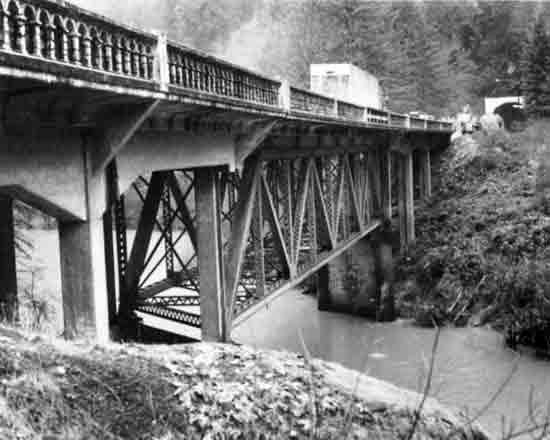 |
|
One of the four Elk Creek crossings built in 1931 on the Umpqua Highway, this bridge, the adjacent Elk Creek Tunnel, and the Elk Creek (4th Crossing) Bridge form almost a continuous structure. This structure, designed by Conde B. McCullough, is a 140-foot steel deck truss (Warren with verticals). It displays an ornate bridge railing, as do the other three Elk Creek crossings. | |
|
Elk Creek (Fourth Crossing) Bridge Structure Number 1406 Constructed - 1931 Steel Deck Truss (Warren with Verticals) Umpqua Highway 45, M.P. 39.97 Elkton vicinity, Douglas County Ownership - State of Oregon |
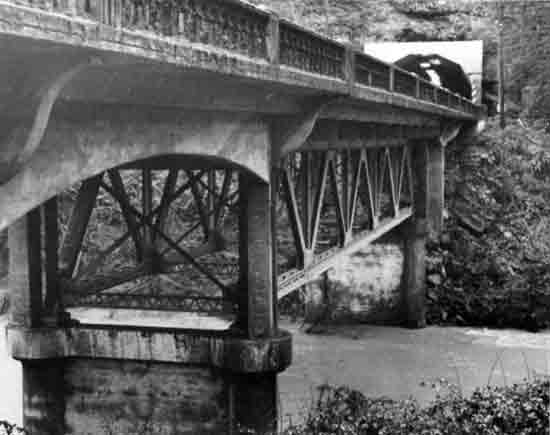 |
|
This 100-foot steel deck truss is a Warren with verticals. Its design is attributed to Conde B. McCullough, State Bridge Engineer. The bridge is one of four Elk Creek crossings constructed in 1931 on the Umpqua Highway. (The second crossing structure is a reinforced concrete deck girder and is shown later in this appendix.) Portions of the original ornamental sidewalk railing have been replaced. | |
ARCH
|
Grande Ronde River Bridge (Perry Overcrossing) Structure Number 626 Constructed - 1924 Reinforced Concrete Deck Arch Old Oregon Trail Highway 6, M.P. 256.31 (Frontage Road) La Grande vicinity, Union County Ownership - State of Oregon |
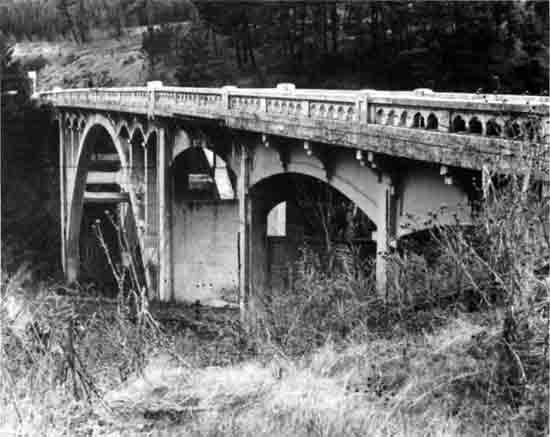 |
|
The Perry Overcrossing, another of Conde B. McCullough's arch bridges, was built on the Hilgard-La Grande section of the Old Oregon Trail Highway. The Union Bridge Company was awarded the contract for this 312-foot long bridge. The main span is a 134-foot reinforced concrete rib deck arch over the Grande Ronde River. The open spandrel arch has curved arch fascia curtain walls, and the piers have partially solid web walls. Small arched openings accentuate the railing, and the railing soffits are ornately curved. The still-intact blast plates above the railroad tracks originally protected the underside of the structure from the intense heat and gases of passing steam engines. | |
|
Umatilla River (Umatilla) Bridge Structure Number 624A Constructed - 1925 Reinforced Concrete Deck Arch Columbia River Highway 2, M.P. 182.60 Umatilla, Umatilla County Ownership - State of Oregon |
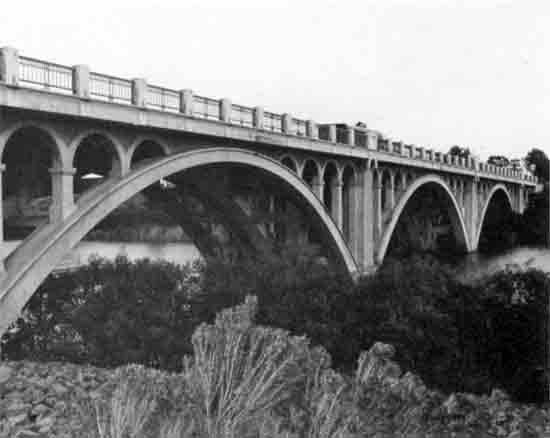 |
|
Dedicated to an early member of the State Highway Commission, William Duby, this 439-foot structure consists of three 110-foot open-spandrel, rib-type, reinforced concrete deck arch spans, and six concrete deck girder approach spans. Designed by Conde B. McCullough, the structure has arched spandrel curtain walls with bush-hammered inset panels. The original decorative concrete railing was removed during a widening project in 1951 and was replaced with a galvanized steel railing typical of the 1950s period. | |
|
Soapstone Creek Bridge Structure Number 1319 Constructed - 1928 Reinforced Concrete Deck Arch Necanicum Highway 46, M.P. 6.50 Necanicum Junction vicinity, Clatsop County Ownership - State of Oregon |
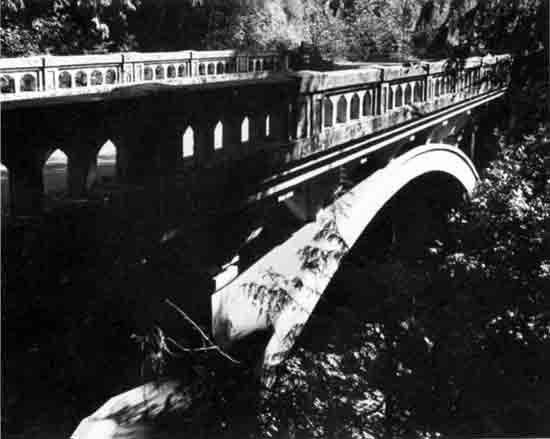 |
|
One of Conde B. McCullough's arch bridges, this structure replaced a wooden covered bridge. The contract for the bridge was awarded to Lindstrom and Feigenson of Portland. The 152-foot structure exhibits many features characteristic of McCullough bridges, including an open spandrel with curved arched fascia curtain walls, precast railings with small arched openings and topped with concrete caps, and curved soffits. When the Soapstone Bridge was constructed in 1928, the present Necanicum Highway was the route of the Oregon Coast Highway. | |
|
Salmon River Bridge Structure Number 4192 Constructed - 1930 Reinforced Concrete Deck Arch Salmon River Highway 39, M.P. 6.23 Rose Lodge vicinity, Lincoln County Ownership - State of Oregon |
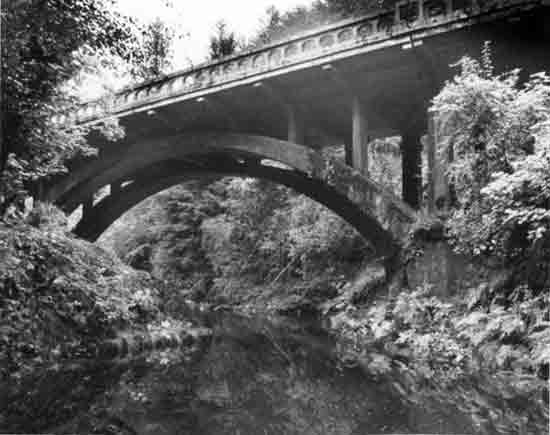 |
|
Constructed by the United State Bureau of Public Roads, the main piers and rib members of this bridge are skewed to allow for passage of the Salmon River. The main span is an 80-foot open-spandrel, rib-type reinforced concrete deck arch. The railing is ornamental, and the spandrel columns curve at the top to form decorative brackets to support the sidewalk and railing. The bridge was designed by H.R. Angwuir, Senior Bridge Engineer, United State Bureau of Public Roads, San Francisco. | |
|
Big Creek Bridge Structure Number 1180 Constructed - 1931 Reinforced Concrete Through Tied Arch Oregon Coast Highway 9, M.P. 175.02 Heceta Head vicinity, Lane County Ownership - State of Oregon |
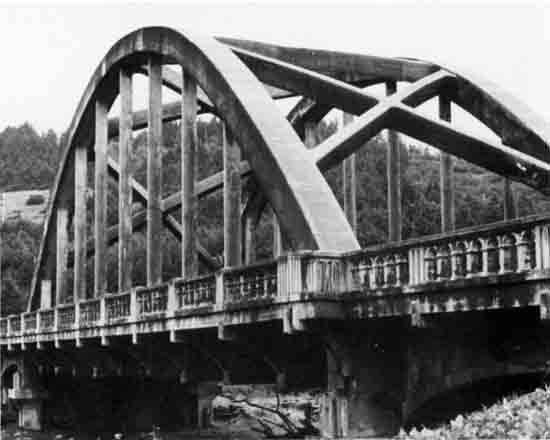 |
|
The main span of the Big Creek Bridge is a 120-foot reinforced concrete through tied arch, elliptical in shape. Very similar in design and size to the Wilson River and Tenmile Creek bridges, the Big Creek Bridge is one of the first reinforced concrete tied arch spans to be constructed in this country. The bridge is well suited to its location and has an attractive precast concrete railing. The concrete deck girder approach spans have arched fascia curtain walls and contribute to an overall structure length of 235 feet. The bridge was designed by Conde B. McCullough, State Bridge Engineer, and constructed by the Union Bridge Company. | |
|
Cummins Creek Bridge Structure Number 1182 Constructed - 1931 Reinforced Concrete Deck Arch Oregon Coast Highway 9, M.P. 178.35 Yachats vicinity, Lane County Ownership - State of Oregon |
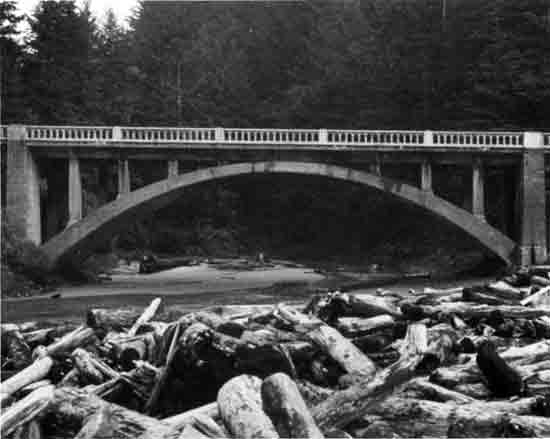 |
|
Located about four miles south of Yachats on the Oregon Coast Highway, the bridge spans Cummins Creek at Neptune State Park. The bridge's total length is 185 feet, and the main span is a 115-foot reinforced concrete rib arch. The arch is an open spandrel type with a low rise. The arch appears to be segmented because of block recessed lines. The main piers and spandrel columns are fluted, as are the railing posts. The railing is supported by curved brackets and consists of small semi-circular arched openings. The structure was designed by Conde B. McCullough, State Bridge Engineer, and built by Tom Lillebo, Contractor. | |
|
Tenmile Creek Bridge Structure Number 1181 Constructed - 1931 Reinforced Concrete Through Tied Arch Oregon Coast Highway 9, M.P. 171.44 Yachats vicinity, Lane County Ownership - State of Oregon |
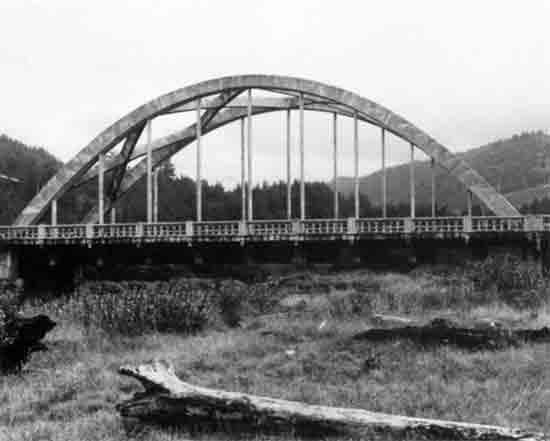 |
|
Located in an attractive stretch of Oregon's coastline, the Tenmile Creek Bridge was designed by Conde B. McCullough, State Bridge Engineer. Along with the Wilson River and Big Creek bridges, the Tenmile Creek Bridge illustrates the first uses of the reinforced concrete tied arch in the United States. The main span is 120 feet, and the total length is 180 feet. The structure has ornate precast concrete railings. | |
|
Hood River (Tucker) Bridge Structure Number 1600 Constructed - 1932 Reinforced Concrete Deck Arch Hood River Highway 281, M.P. 4.95 Hood River vicinity, Hood River County Ownership - State of Oregon |
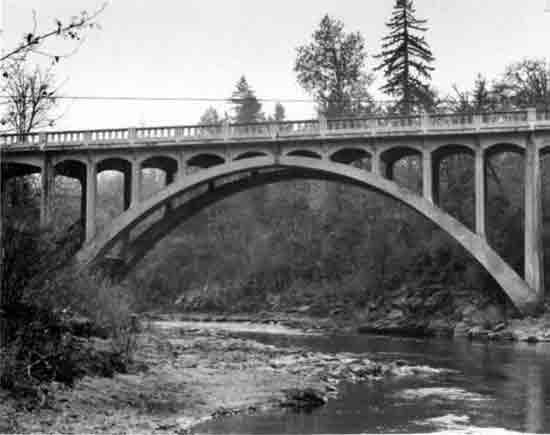 |
|
This structure spans Hood River about four miles south of the city of Hood River. The bridge carries the historic name of Tucker's Bridge. B.R. Tucker built a bridge and sawmill at this location about 1881. The 1932 arch bridge was designed by the State Bridge Engineer Conde B. McCullough, but was built by Hood River County. The bridge was contracted to Charles O. Young. Totaling 188 feet in length, the main span is a 100-foot reinforced concrete rib deck arch. The spandrel columns, main piers and approach columns are slender and have recessed narrow vertical panes. The spandrel columns and approach piers also have a shallow arched fascia curtain walls. The railings are supported by curved brackets and display a series of semi-circular arched openings. | |
|
South Umpqua River (Winston) Bridge Structure Number 1923 Constructed - 1934 Steel Through Tied Arch Coos Bay-Roseburg Highway 35, M.P. 74.47 Winston vicinity, Douglas County Ownership - State of Oregon |
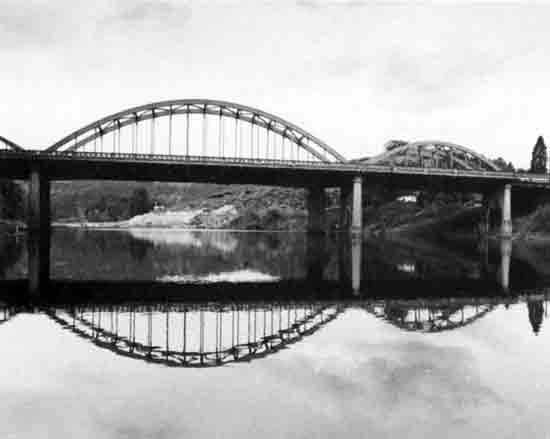 |
|
The Winston Bridge consists of three steel tied arch spans, including a central arch of 180 feet, flanked by two smaller 100-foot arches. There are four concrete deck girder approach spans, giving a total length of 548 feet. The structure was designed by Conde B. McCullough and has an ornate precast concrete railing. and arch openings between the bridge piers. | |
|
Clackamas River (Estacada) Bridge Structure Number 2208 Constructed - 1936 Reinforced Concrete Deck Arch Woodburn-Estacada Highway 161, M.P. 33.40 Estacada, Clackamas County Ownership - State of Oregon |
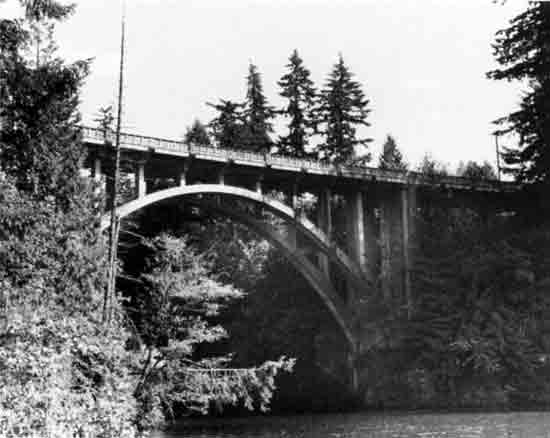 |
|
The main span of this 371-foot structure is a 140-foot open-spandrel, rib-type reinforced concrete deck arch between eight concrete deck girder approach spans. The main arch has a very high rise. The roadway is skewed on the structure. The structure was designed by Conde B. McCullough and is embellished with a decorative precast concrete railing, elaborate projecting brackets, and lean, tall spandrel columns. This bridge replaced a timber Howe truss covered bridge at this site. The arch bridge was constructed by the Mountain States Construction Company, Eugene. | |
|
Nehalem River Bridge Structure Number 2165 Constructed - 1939 Reinforced Concrete Deck Arch Sunset Highway 47, M.P. 21.73 Elsie vicinity, Clatsop County Ownership - State of Oregon |
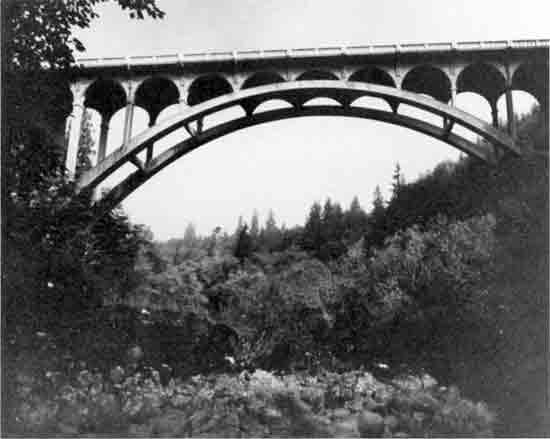 |
|
This 617-foot long structure consists of a 231-foot open-spandrel, rib-type reinforced concrete deck arch, and eleven concrete deck girder approach spans. The approach and spandrel columns have semi-circular arched fascia curtain walls. The approach piers also have arched fascia walls. The slimness of the arch ribs, piers, and columns contribute to the attractive appearance of the bridge. Long brackets support the ornamental bridge railings and sidewalks. The designer of the bridge was Glenn S. Paxson, State Bridge Engineer. The bridge was built by the Mountain States Construction Company, Eugene. | |
MOVEABLE
|
Willamette River (Van Buren Street) Bridge Structure Number 2728 Constructed - 1913 Steel Through Truss (Pratt) Swing Corvallis-Lebanon Highway 210, M.P. 0.13 Corvallis, Benton-Linn counties Ownership - State of Oregon |
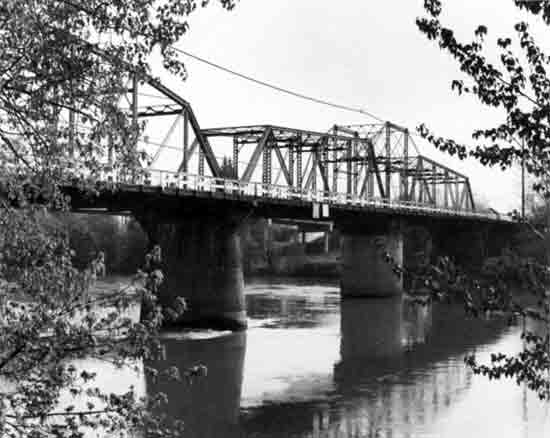 |
|
This three-span structure is the oldest swing-span bridge in Oregon and is the only pin-connected swing-span truss. It was constructed by the Coast Bridge Company and consists of a 249-foot steel through truss swing span, a 171-foot steel through truss, a 57-foot steel pony truss, and nine 19-foot timber spans. The mechanism to operate the swing span was removed in the 1950s, and there is little decorative or architectural treatment on the structure. The bridge was originally built by Benton County, but now belongs to the state. | |
|
Old Young's Bay Bridge Structure Number 330 Constructed - 1921 Steel Double-Leaf Bascule Warrenton Highway 105, M.P. 6.89 Astoria vicinity, Clatsop County Ownership - State of Oregon |
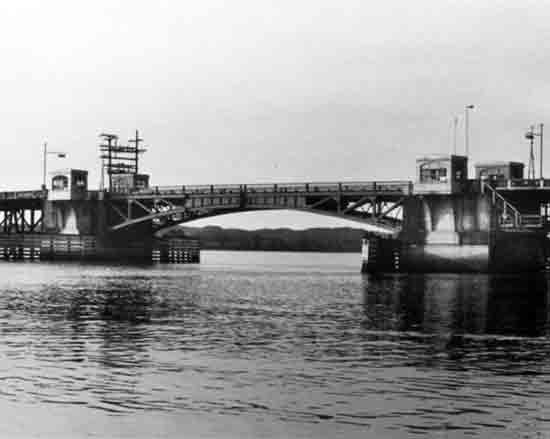 |
|
This steel double-leaf bascule drawspan structure was the first moveable span bridge designed by state bridge engineer Conde B. McCullough. The 150-foot central bascule span consists of two 75-foot central cantilevered sections operated by 40 horsepower electric motors and counterweights. Fifty-eight pile trestle secondary spans and ten timber stringer spans carry 1,616 feet of approach roadway to the central span and contribute to an overall structure length of 1,766 feet. Typical of McCullough designs, large ornate approach pylons with lanterns stand on either side of the roadway at both ends of the structure. | |
|
Columbia River (White Salmon) Bridge Structure Number 6645 Constructed - 1924 Steel Through Truss (Pennsylvania-Petit) Vertical Lift Port Road connecting with Columbia River Highway 2, M.P. 64.62 Hood River, Hood River County (Oregon) and White Salmon, Klickitat County (Washington) Ownership - Port of Hood River |
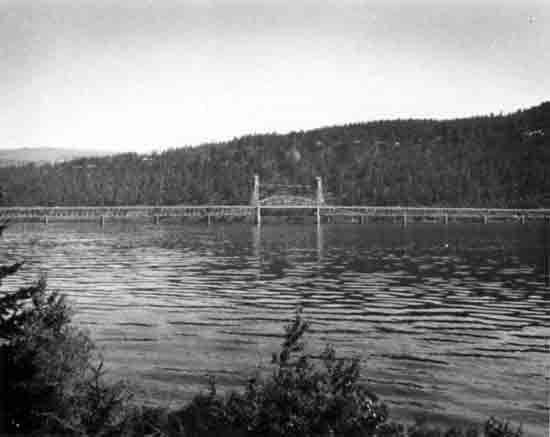 |
|
The White Salmon Bridge is the second oldest highway bridge across the Columbia River between Oregon and Washington. The 4,755-foot long toll bridge consists of a 262-foot steel through Pennsylvania-Petit truss vertical lift span and sixteen 206-foot steel deck truss secondary spans. The bridge, originally called the Waucoma Interstate Bridge, was constructed by Gray and Chandler, under the direction of Professor C.B. Wing of Stanford University, for the Oregon-Washington Bridge Company. The bridge was originally not a moveable span structure, but was converted to a vertical lift type in 1939 in conjunction with the completion of the Bonneville Dam downstream. | |
|
Lewis and Clark River Bridge Structure Number 711 Constructed - 1924 Steel Single-Leaf Bascule Warrenton Highway 105, M.P. 4.78 Astoria vicinity, Clatsop County Ownership - State of Oregon |
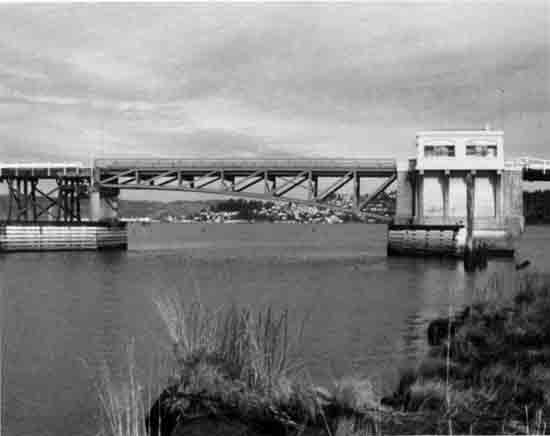 |
|
The Lewis and Clark River Bridge is the only remaining single-leaf bascule drawspan built before World War II. The central span is a 112-foot steel single-leaf bascule span operated by dual electric motors and provides 105 feet of lateral waterway clearance. Forty-eight pile trestle and stringer spans carry 716 feet of approach roadway, contributing to a total structure length of 828 feet. Designed by Conde B. McCullough, the bridge was constructed, along with the Old Young's Bay Bridge, as part of an improvement project for the coastal area. | |
SLAB, BEAM, AND GIRDER
|
N.E. Grand Avenue Overcrossing Structure Number 7040 Constructed - 1907 Steel Deck Girder Pacific Highway East 1E, M.P. 0.20 Portland, Multnomah County Ownership - State of Oregon |
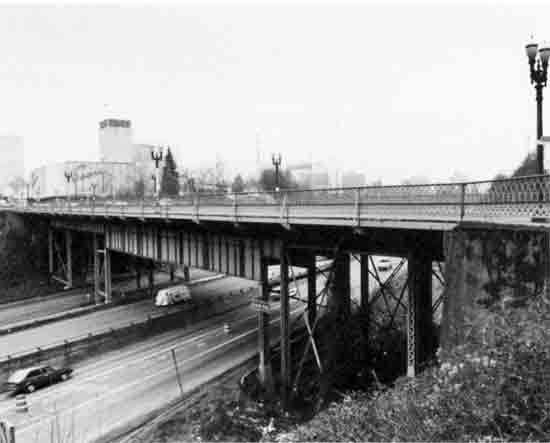 |
|
This seven-span, 352-foot steel deck girder is the fifth oldest highway bridge in Oregon and the oldest slab, beam, and girder type structure. A plaque mounted on the ornate lattice-steel railing indicates the bridge was built by the International Contract Company of Seattle, Washington. The original decorative lampposts and lanterns are on the bridge. This was the first major span across Sullivan's Gulch. Interstate 84 and the Union Pacific Railroad pass under the structure. | |
|
N.E. 12th Avenue Overcrossing Structure Number 7039 Constructed - 1910 Steel Deck Girder N.E. 12th Avenue, over Interstate 84 and the Union Pacific Railroad Portland, Multnomah County Ownership - City of Portland |
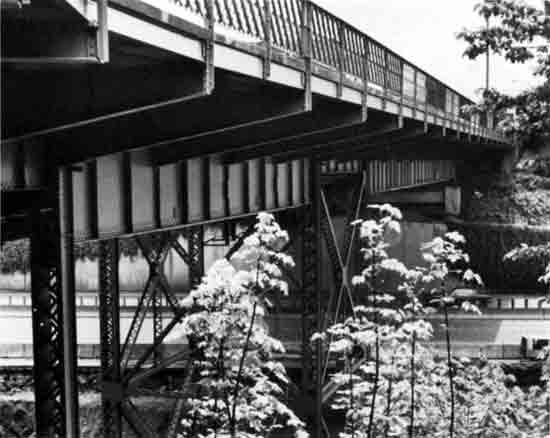 |
|
Built in 1910 as the third major crossing of Sullivan's Gulch, this structure is a 320-foot steel deck girder on steel towers. The main span of the bridge was altered during the construction of the Banfield Freeway in 1956, but the work was smoothly integrated into the original design. The vintage lattice steel sidewalk railing was retained. The structure was designed by Waddell and Harrington, Kansas City, Missouri, and was constructed by the International Contract Company, Seattle. | |
|
McCarthy Creek Bridge Structure Number Unknown Constructed - Ca. 1914 Reinforced Concrete Deck Girder Lower Columbia River Highway 2W, M.P. 13.19 (Bypassed) Portland vicinity, Multnomah County Ownership - State of Oregon |
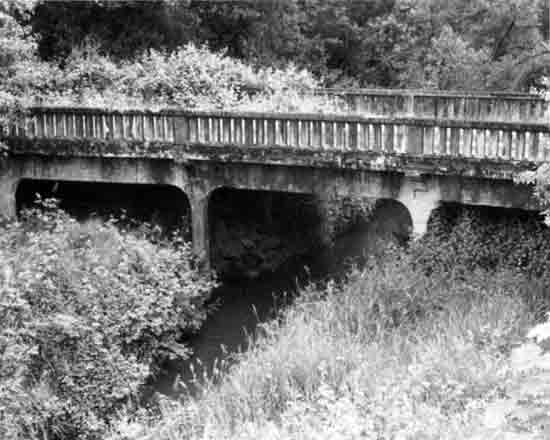 |
|
Little information has been obtained on this abandoned concrete deck girder span northwest of Portland. It was originally constructed on the Lower Columbia River Highway, but now lies abandoned next to a new bridge. | |
|
Johnson Creek Bridge Structure Number 51C02 Constructed - 1915 Reinforced Concrete Slab S.E. Tacoma Street Portland, Multnomah County Ownership - City of Portland |
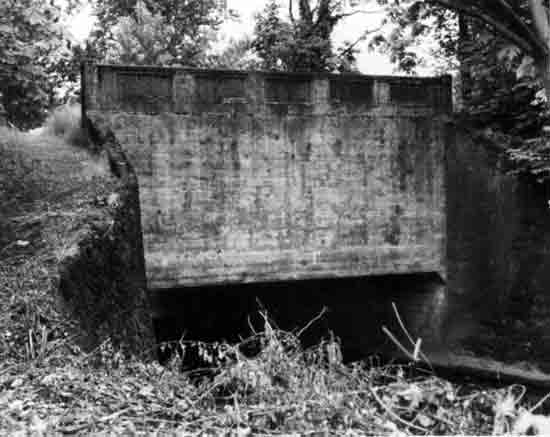 |
|
This structure is a 28-foot concrete slab span built in 1915 and located at the south end of the Eastmoreland Golf Course in southeast Portland. The structure is joined to a large curved retaining wall which is topped by an ornate spindle balustrade railing. It is not known whether this is part of the original structure or added at a later date. | |
|
Columbia Slough (N.E. Union Avenue) Bridge Structure Number 1377C Constructed - 1916 Steel Deck Girder N.E. Union Avenue Crossing of the Pacific Highway East 1E, M.P. 4.41 Portland, Multnomah County Ownership - State of Oregon |
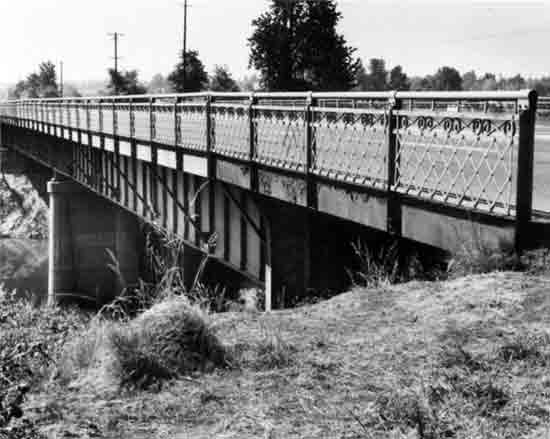 |
|
Consisting of four 76-foot steel deck girder spans, this 304-foot structure was constructed in 1916 as part of the approach roadway leading to the Interstate Bridge (1917) over the Columbia River. It is very similar to the Oregon Slough Bridge on Interstate 5 at the Interstate Bridge, which was built at the same time and which exhibits the same ornate vintage lattice steel railing. | |
|
Rhea Creek Bridge Structure Number 49C23 Constructed - 1916 Reinforced Concrete Through Girder Ruggs-Jordan County Road 581 Jordan vicinity, Morrow County Ownership - Morrow County |
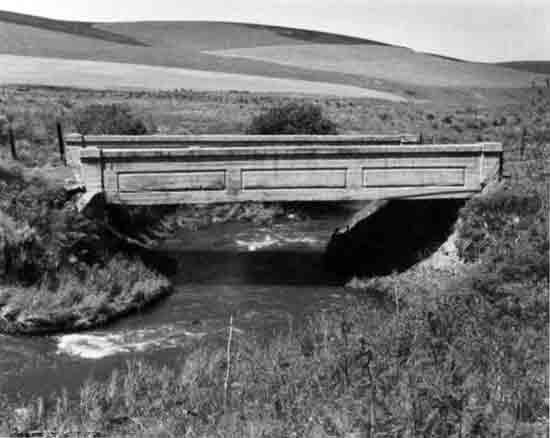 |
|
Located on a lightly-traveled unpaved county road, this is one of only two known concrete through girder spans on Oregon's highway system. (The other is the Bridal Veil Falls Bridge, constructed in 1914 on the old Columbia River Highway.) The structure is 42 feet long. The end post provides the name of the builder, John W. Ash, and the date of construction. The design for the bridge was provided to the county by the State Highway Department. | |
|
Mosier Creek (State Road) Bridge Structure Number 118 Constructed - 1917 Reinforced Concrete Deck Girder State (County) Road Mosier vicinity, Wasco County Ownership - Wasco County |
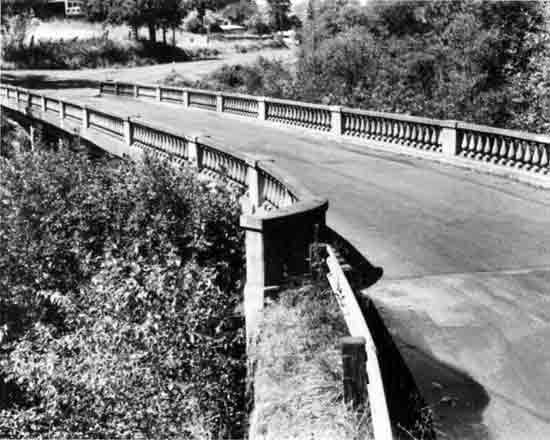 |
|
This 175-foot structure consists of five 35-foot reinforced concrete girder spans. The structure is given aesthetic interest by the spindle-type balustrade railing. This bridge was designed by the state, but built by Wasco County. The bridge plans are signed by State Highway Department bridge designer L.W. Metzger. The bridge was built concurrent with the construction of the old Columbia River Highway in Wasco County, but was not on the route of the Columbia River Highway. | |
|
Beltline Overcrossing Structure Number 2418 Constructed - 1921 Reinforced Concrete Slab Warrenton Highway 105, M.P. 7.10 Astoria vicinity, Clatsop County Ownership - State of Oregon |
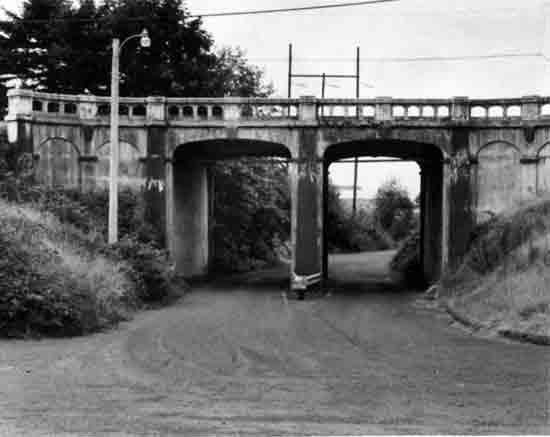 |
|
Originally constructed as a railroad overpass, this bridge is the most ornate concrete slab structure in Oregon. It consists of two 18-foot reinforced concrete slab spans which have arched fascia walls with keystones. Arches, columns, and keystones embellish the wing walls. The precast concrete railing is a typical 1920s design. The structure is located near the old Young's Bay Bridge, built in the same year. | |
|
Euchre Creek Bridge Structure Number 15C31 Constructed - 1927 Reinforced Concrete Deck Girder Ophir County Road 510 Ophir, Curry County Ownership - Curry County |
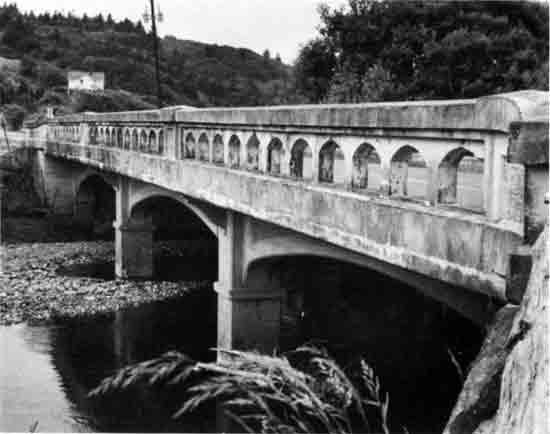 |
|
This structure is a 90-foot reinforced concrete deck girder, consisting of three 30-foot spans. The arched girder members with bush-hammered insets, soffit brackets, and precast arched concrete railing make this a good example of late 1920s bridge construction. This bridge was originally on the Oregon Coast Highway, but is now on a bypassed section. | |
|
Pringle Creek Bridge (Commercial Street, South) Structure Number 1340 Constructed - 1928 Reinforced Concrete Deck Girder Pacific Highway East 1E, M.P. 50.59 Salem, Marion County Ownership - State of Oregon |
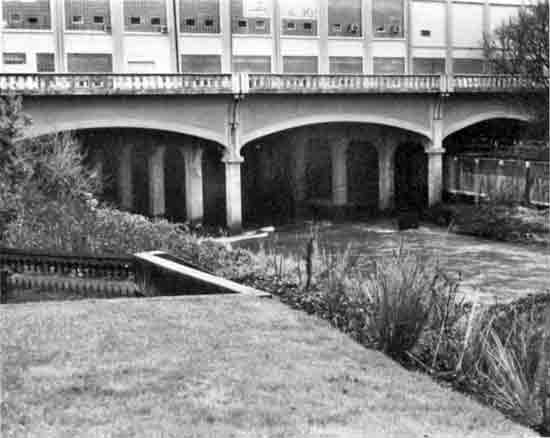 |
|
One of the bridges built during Salem's bridge construction program of 1928-29, this 192-foot structure consists of four 48-foot reinforced concrete deck girder spans and features the same ornamental railing, brackets, and arched girder members which appear on all the bridges built during the program. East of the bridge is the landscaped grounds of Salem's Civic Center and westward is the Boise-Cascade Paper Mill. | |
|
Mill Creek (Summer Street, N.E.) Bridge Structure Number 1357S Constructed - 1929 Reinforced Concrete Deck Girder Pacific Highway East 1E, M.P. 49.28 Salem, Marion County Ownership - State of Oregon |
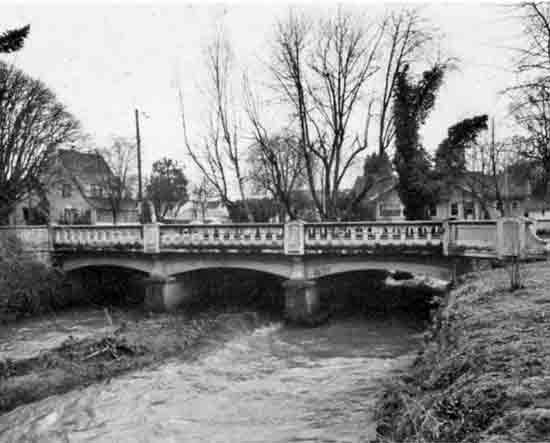 |
|
This small bridge exhibits the ornamental bridge railing, arched girder members, bush-hammered insets, and bracketing common to most of the bridges constructed during Salem's bridge construction program of 1928-29. The Summer Street Bridge is a 60-foot, reinforced concrete deck girder, consisting of three 20-foot spans. The bridge is located several blocks north of the State Capitol. | |
|
Elk Creek (Second Crossing) Bridge Structure Number 1601 Constructed - 1931 Reinforced Concrete Deck Girder Umpqua Highway 45, M.P. 38.76 Elkton vicinity, Douglas County Ownership - State of Oregon |
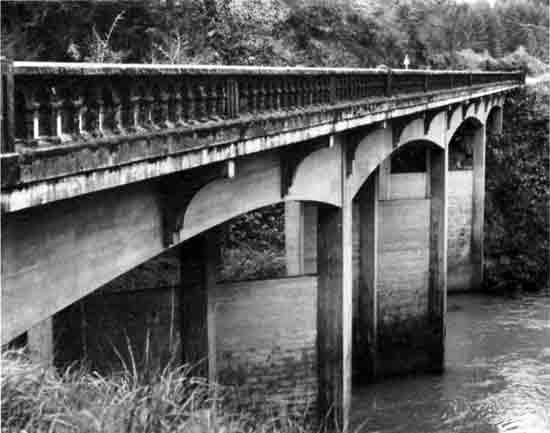 |
|
Unlike the other three Elk Creek crossings built on the Umpqua Highway, the second crossing structure is a concrete deck girder, while the others are steel deck trusses. This structure consists of six spans totaling 290 feet and has the same ornate bridge railing found on the other Elk Creek bridges. Design by Conde B. McCullough, the structure was built by Odom and Frazier, Contractors. | |
|
Link River Bridge Structure Number 1579 Constructed - 1931 Reinforced Concrete Deck Girder Klamath Falls-Lakeview Highway 20, M.P. 0.02 Klamath Falls, Klamath County Ownership - State of Oregon |
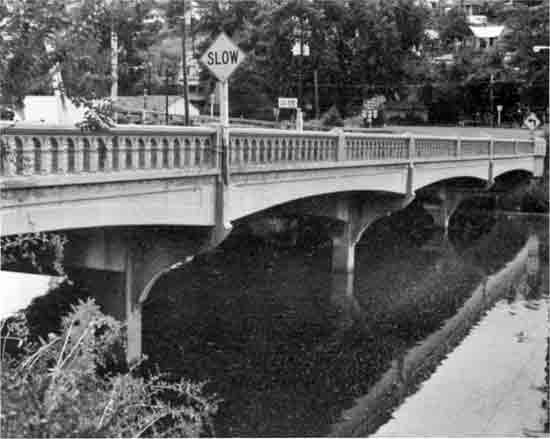 |
|
Fluted entrance pylons, graceful arched girder members, bracketing, and ornate railings are architectural features on this 200-foot concrete deck girder bridge in Klamath Falls. The four-span structure was designed by the State Highway Department and constructed by Lindstrom and Feigenson, Contractors. On the approach railing at the east end of the bridge is a bronze plaque commemorating the founding of Linkville, later called Klamath Falls, founded in 1867 by pioneer George Nurse. | |
|
Portland Road, N.E., Undercrossing Structure Number 2131 Constructed - 1936 Steel Deck Girder Pacific Highway East 1E, M.P. 47.78 Salem, Marion County Ownership - State of Oregon |
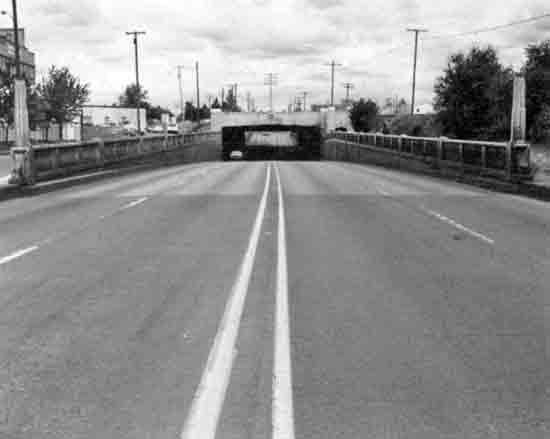 |
|
Designed by Conde B. McCullough, this underpass has decorative fluted pylons, two pedestrian tunnels, and attractive gothic-arch balustrade railings typical of Depression-era structures. The main structure is a 49-foot steel deck girder span over 100 feet wide, its large width due to the skewed approach of the railroad tracks to the roadway. | |
| <<< Previous | <<< Contents>>> | Next >>> |
appe.htm
Last Updated: 06-Aug-2008